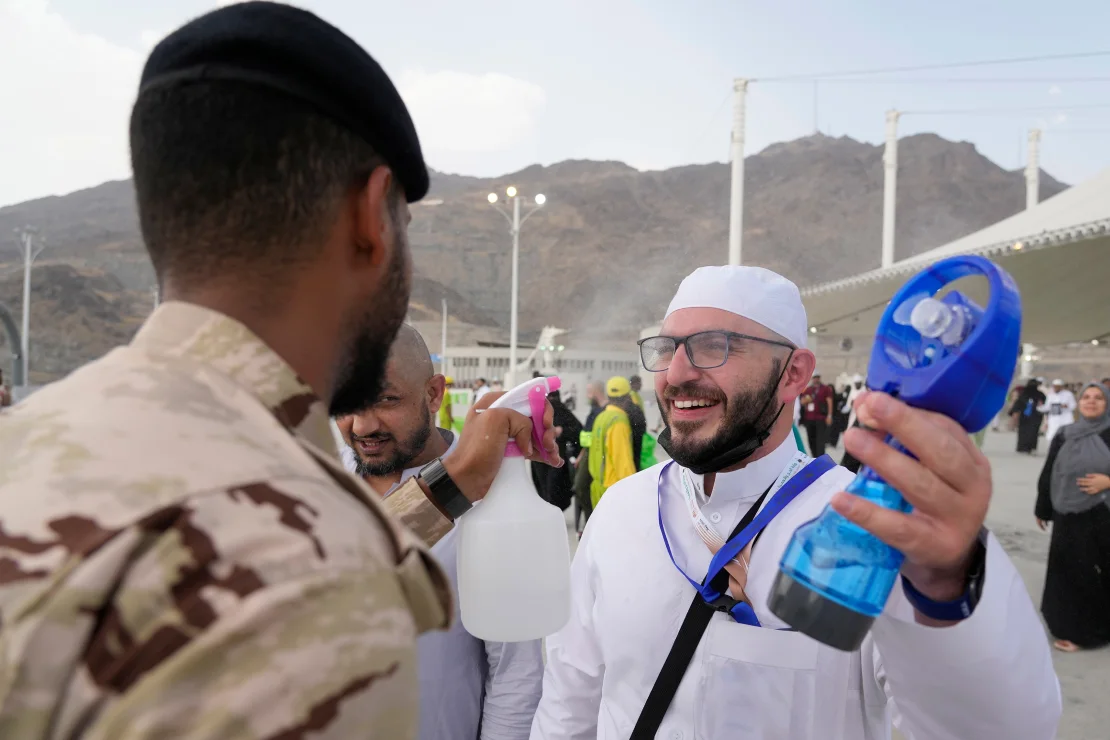A pilgrim receives cold water spray in Mina near the holy city of MeccaRafiq Maqbool/AP
The death toll from this year’s Hajj pilgrimage has surged to nearly 500, with fears that the true number could exceed 1,000. Reports indicate that up to 600 Egyptian worshipers may have died en route to Mecca due to extreme heat.
Authorities have confirmed fatalities among several nationalities: 14 Malaysians, 165 Indonesians, 75 Jordanians, 35 Pakistanis, 49 Tunisians, 11 Iranians, and 98 Indians. The US State Department also confirmed multiple American deaths but did not provide specific numbers.
Rising Death Toll and Heatwave Conditions
The extreme heat has resulted in dozens of hospitalizations, particularly among Iranians who suffered from heatstroke and related conditions. According to a CNN tally, at least 480 pilgrims have died, with numbers expected to rise as Saudi Arabia and Egypt release further data. Many of the deceased were not registered pilgrims, adding to the challenge of accurate reporting.
Pilgrims faced temperatures as high as 49 degrees Celsius (120 degrees Fahrenheit). Despite safety measures such as cooling stations and advisories to stay hydrated, the heat proved fatal for many.
Egypt has set up a crisis unit headed by Prime Minister Mostafa Madbouly to support the families of the deceased. President Abdel Fattah el-Sisi has instructed the unit to coordinate with Saudi authorities for the speedy return of the bodies. Official Egyptian figures currently stand at 28 dead, though reports suggest the true toll could be between 500 and 600.
The crisis highlights the vulnerability of unregistered worshipers who lack access to official facilities. Thousands have been treated for heatstroke, with the Saudi Ministry of Health implementing various safety measures.
Global Impact and Response
Jordanian officials reported that of the dozens of Jordanians who died, at least 68 have been granted burial permits in Mecca. Malaysia’s Minister for Religious Affairs, Dr. Mohd Na’im Mokhtar, stated that most Malaysian fatalities were due to heart disease, pneumonia, and blood infections.
India confirmed 98 deaths among its nationals, attributing these to natural illnesses, chronic conditions, and old age. Six Indians died at Mount Arafat during extreme heat, while four others perished in accidents.
In Tunisia, the deaths led to the dismissal of the Minister of Religious Affairs, Ibrahim Chaibi, amid concerns of negligence. The Saudi government reported treating over 2,700 people for heatstroke, with social media flooded with accounts of missing loved ones.
This year’s Hajj, one of the world’s largest religious gatherings, saw participation from 1.8 million people. The event, held amid sweltering temperatures, raised questions about safety measures and the management of such a large influx of pilgrims.
Economic and Religious Significance
The Hajj holds significant religious and economic importance for Saudi Arabia. The kingdom’s efforts to expand the Grand Mosque in Mecca and plans to increase pilgrimage revenue reflect its economic diversification goals. Despite generating close to a billion dollars daily from oil, Saudi Arabia sees untapped potential in pilgrimage revenues, aiming to attract 30 million pilgrims by 2030.
The pilgrimage’s rituals, including the symbolic stoning of the devil and the wearing of special garments, underscore the religious significance of Hajj. As the Custodian of the Two Holy Mosques, Saudi Arabia’s king holds a prestigious role, with the pilgrimage being a key component of the kingdom’s cultural and economic identity.
The tragedy of this year’s Hajj underscores the need for improved safety measures to protect pilgrims from extreme weather conditions, ensuring their journey remains a fulfilling spiritual experience.
#Hajj2024 #HeatwaveTragedy #SaudiArabia #PilgrimageSafety #GlobalNews
